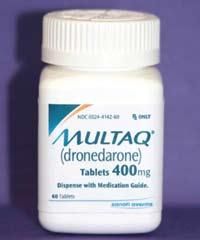Publication
Article
Pharmacy Times
Rx Product News Profile: A closer look at new FDA actions: Multaq
Author(s):
Dr. Holmberg is the pharmacy coordinator at Desert Vista Behavioral Health Center in Mesa, Arizona.
Sanofi-aventis’ Multaq
The FDA has approved sanofi-aventis’ Multaq (dronedarone) for adult patients with atrial fibrillation or atrial flutter.1 Multaq has been shown to reduce the risk of cardiovascular hospitalizations. It is indicated for patients with paroxysmal or persistent atrial fibrillation or atrial flutter who have recently experienced an episode of atrial fibrillation or atrial flutter and who have cardiovascular risk factors (age >70 years, hypertension, diabetes, previous cerebrovascular accident, left atrial diameter ≥50 mm or left ventricular ejection fraction of <40%) and who are in sinus rhythm or who will be cardioverted.2
Atrial fibrillation affects an estimated 2.5 million Americans, and it is currently the leading cause for arrhythmiarelated hospitalization in the United States. Patients with atrial fibrillation have up to 5 times the risk for stroke than patients without atrial fibrillation. Although atrial flutter occurs less frequently, it may eventually become atrial fibrillation.1
Mechanism of Action
Multaq’s mechanism of action is currently unknown. It demonstrates antiarrhythmic properties of all 4 Vaughan- Williams classes.2
Dose
Multaq is dosed as 400 mg twice daily with the morning and evening meals.2
Contraindications, Warnings, and Precautions

Multaq carries a boxed warning regarding its contraindication in patients with New York Heart Association (NYHA) Class IV heart failure or symptomatic NYHA Class II or III heart failure with a recent decompensation that required hospitalization or referral to a specialist.
Multaq also is contraindicated in patients with second- or third-degree atrioventricular block or sick sinus syndrome, unless its use is in combination with a functioning pacemaker. Multaq is contraindicated in patients with bradycardia <50 beats per minute; concomitant use of a strong cytochrome P (CYP)3A4 inhibitor; concurrent use of medications or herbal products that may prolong the QT interval and may lead to torsade de pointes; QTc Bazett interval ≥500 ms; and severe hepatic impairment. Multaq is Pregnancy Category X and should not be used in patients who are pregnant or breastfeeding.
Treatment with Multaq should be interrupted or discontinued in patients in whom heart failure develops or worsens. Ensure that both potassium and magnesium levels are maintained within normal ranges prior to and during treatment with Multaq. If the QTc Bazett is ≥500 ms, Multaq should be discontinued. Patients may experience an increase in serum creatinine within the first week of treatment with Multaq; this increase does not represent a change in renal function. Women who may become pregnant should use effective contraception during treatment with Multaq.
The most common adverse reactions to Multaq are diarrhea, nausea, abdominal pain, vomiting, and asthenia.2
Drug Interactions
Multaq is metabolized by CYP3A and is a moderate inhibitor of CYP3A and CYP2D6. As a result, concurrent administration of some medications may require extra monitoring or therapeutic adjustments.
Avoid concurrent use of antiarrhythmic agents, CYP3A inducers, and grapefruit juice. If discontinuation of digoxin is not a feasible option, the dose should be halved, and therapy should be monitored appropriately. Treatment with beta-blockers and calcium channel blockers should be initiated at low doses and increased only after tolerability has been confirmed by and electrocardiogram. Administration of 3-hydroxy-3-methylglutaryl-coenzyme A reductase inhibitors should be according to the manufacturer’s recommendation for treatment with a statin and a CYP3A and P-glycoprotein inhibitor. Other substrates of CYP3A with a narrow therapeutic index (sirolimus and tacrolimus) should be monitored carefully with dosage adjustments made as necessary.2







